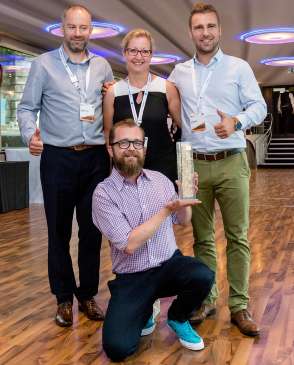Combining EHS and risk management is a topic that is discussed frequently. But what does it actually mean? What happens when you combine EHS and risk, and what are the benefits from managing the two simultaneously through a common software system? The best way to answer these questions is to look at a real-life example. To do that, we turn to the Enablon community of industry-leading companies, such as MOL Group.
MOL Group is an integrated, international oil and gas company headquartered in Hungary, and is present in over 30 countries with a workforce of 26,000 people. MOL is vertically integrated and active in all areas of the oil and gas industry, including upstream (exploration and production), midstream, downstream (refining and petrochemicals), and consumer services (retail, distribution and marketing). At MOL, over 20,000 people use the Enablon Incident/Event Management module, and the Risk Management module has also been introduced.
MOL Group received the at SPF EMEA 2018 for successfully reducing risks and improving EHS performance through a common software system.

The MOL Group team at SPF EMEA 2018
Let’s look at three concrete examples of how MOL is combining EHS and risk management through a single, integrated platform, and the benefits produced by having “everything in one place”.
Increasing Visibility Over Risks Across the Enterprise
MOL has exploration and production activities in 13 different countries across 3 continents, ranging from its core Central & Eastern European region to countries like the UK, Norway, CIS states, Pakistan, Oman, Angola and Egypt. But some risks don’t recognize national borders. If something goes wrong at one site, it is in the interest of all sites to be aware of it, in order to ensure safety.
As a result of having a single platform for EHS and risk management, when an incident occurs, three things happen at MOL: 1) the causes that led to the incident are identified, 2) a determination is made whether the same risk exists at other sites, and 3) everybody across all applicable sites becomes aware of the potential presence of the risk. Thus the level of awareness of risks is uniform across the entire organization.
When a risk is identified, it could take up to 12 months to implement corrective and preventive action plans, and for these 12 months the risk is still present. But at least for that time period all sites are aware of the risk and can take temporary measures until the permanent controls are implemented.
Using Information on Incidents to Mitigate Risks
When a safety incident occurs at one site, there can be valuable information that can be leveraged to mitigate a risk across all sites. But to achieve this, there must be a successful exchange of information between the occupational safety and risk functions. This exchange of information is greatly facilitated when a single platform is used for EHS and risk management.
Let’s look at how this works at MOL. When an incident occurs, an incident investigation is launched. The results of the investigation may lead to the identification of a new risk, which then triggers a risk assessment in the Enablon Risk Management module. The controls needed to mitigate the risk, and that were identified by the risk assessment, are then deployed across all applicable sites through action plans to ensure their successful implementation.
Here’s a recap of the steps: 1) an incident is recorded in the Enablon Incident/Event Management module, 2) an incident investigation is performed, 3) a risk assessment is conducted in the Enablon Risk Management module, and 4) action plans are launched to implement controls. The process is seamless through a single, integrated platform, which helps to leverage information on incidents to mitigate risks.
Making More Informed Budgeting Decisions
Financial resources are limited. If they weren’t, risk management would be easier because you would simply spend whatever amount it takes to implement the most effective controls for all risks, and eliminate or mitigate all of them. But we don’t live in such a world and decisions need to be made based on available resources.
In the previous section, we saw how a risk assessment leads to an action plan. There are costs associated to action plans and the implementation of controls, and since resources are limited, MOL needs to be sure that the highest priority risks first get the resources required, and then the lower priority risks can share what is left.
The budgeting process is improved through a single, integrated platform because reports can be produced that combine the priority of risks and the resources required to implement controls through action plans. An overview is gained over the initiatives to improve safety, their costs and their priorities. MOL can then easily see what should or can be done and at what cost, leading to more informed budgeting decisions. Igor Milic, Asset Risk Expert at MOL Group, says: “We will have everything in one place and then when you need to make some kind of budgeting decision you will be able to create the report to see ‘Oh, I need to do those things, they cost that much money, this is how each of them is important.’ ”
In addition to tangible improvements, there is also an organizational benefit for MOL from combining EHS and risk management through a single, integrated platform: The workforce develops greater risk awareness. This will lead to an organizational culture where people will have a risk mindset. They will constantly think about risks and risk assessments, which will keep them safe. That’s the ultimate goal, and managing EHS and risk on a single platform will contribute in making that goal a reality!
As a result of using Enablon to successfully reduce risks of incidents and improve EHS performance, we’re proud to have designated MOL Group as the winner of the at SPF EMEA 2018. The recognition is fully deserved, and we look forward to being a part of MOL’s journey towards establishing a risk-aware organizational culture that keeps employees safe.




